7 pre-war dream machines bound for auction in Paris
The festivities surrounding Paris Rétromobile may be postponed this year, but several auction houses are nonetheless holding sales in modified form. Along with its usual crop of race cars, Paris’ annual February sales are in normal circumstances a major destination for pre-war vehicles and their enthusiasts. Pre-war cars in particular deserve to be seen in person to fully appreciate their craftsmanship and engineering, but we’ll do our best to bring them to life with their fascinating histories. Here are seven pre-war cars we’re eager to see cross the auction block in Paris next month.
1913 Brasier 16 HP Panoramic limousine by Marcel Guilloux
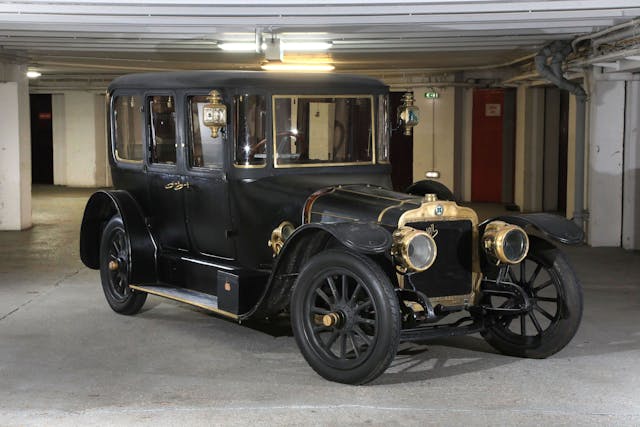
Estimate: $49,000—$73,500
Brasier was very successful in competition in the early days of the motorcar, winning the famous Gordon Bennett Cup in 1904 and 1905. One of the lauded French brands in the years before 1914, Brasier is noted for its excellent build quality. Based on the 16HP chassis, which was the company’s mid-range offering at the time, this automobile wears an elegant and innovative body with panoramic corner windows, made by the coachbuilder Marcel Guilloux de Châlon-sur-Saône. The interior is completely original, boasting horn handles, automatic roller blinds for each window, folding seats, and electric lighting.
This remarkably well-preserved example spent 60 years hidden behind a wall in a shed. Its first owner sealed it off in the shed before he headed out to serve in the French army in the first World War. He was killed in the conflict, and so the car was left untouched until the 1970s, when the new owners of the property discovered it when they knocked down a wall to extend their living space.
We can only find record of five Brasiers going to auction, and 60 percent of those have been in Europe. A very early 1906 car sold for $81,500 in 2016—the highest sold price. A 9HP tourer sold for $15K in 2019. These don’t come up often, so it’ll be interesting to see if any Brasier fans come out of the woodwork to claim this 108-year-old machine.
1932 Bugatti Type 55 by Van Vooren

Estimate: $4.9M—$7.4M
Produced by Bugatti from 1932 to 1935, the Type 55 is the road-going version of the Type 51 Grand Prix car. The Type 55 was introduced at the 1931 Paris Motor Show; just 38 cars were produced in total. The majority of Type 55s had factory bodywork designed by Jean Bugatti, with 16 of the 38 being two-seater roadsters bodies and another seven with coupe bodies, also of the younger Bugatti’s design. Of the remaining fifteen, eleven of the cars were bodied by outside coachbuilders and the other four are unidentified. None of the factory-bodied cars had doors, which made them rather less practical than the cars bodied by external coachbuilders, most of which did have doors.
The Type 55 on offer here, Chassis 55204, was the first chassis of this new model ordered and paid for by Dominique Lamberjack, Jr., Bugatti’s agent in Paris. Every other chassis was to have gone to Lamberjack, and he sent a deposit of 500,000 francs to seal the deal. When Lamberjack had not received his allotment despite the first five private clients having received theirs, he phoned the factory to inquire why. He was told by Bugatti’s accountant that as soon as Ettore had received the money, he had squandered it all on tapestries. Eventually the situation was resolved and Lamberjack received his cars. Of the six Bugatti Type 55 chassis delivered to Paris, five were bodied by Vanvooren and one by Figoni. 55204 was sent to the Vanvooren workshop in Courbevoie to be given a very attractive two-seater cabriolet body. This car was the winner of the first Lyon-Charbonnières Rally. The chassis, engine, gearbox, and axle are all numbers-matching; 70 percent of the wooden frame and bodywork are original. The car has been totally restored to very high standards.
Most recently, in March 2020, a Type 55 Super Sports Roadster sold for $7.1M at Amelia Island, and the record for this car is $10.4M, sold with Gooding back in 2016. This exact car last sold in 2015 for $1.35M at Rétromobile, so any sale within the estimated range would be a big jump.
1931 Bentley 4½-Litre Supercharged Tourer
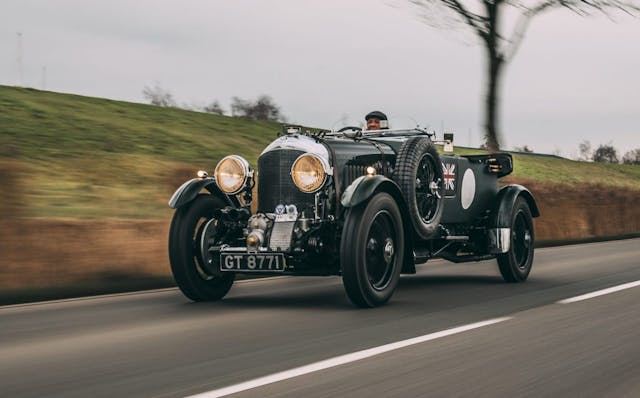
Estimate: $4.97M—$6.06M
Vintage Bentleys, or “W.O.s,” were produced from 1919 to 1931 under the auspices of founder Walter Owen Bentley at Cricklewood, in Northwest London. In 1931, Rolls-Royce purchased Bentley and moved its works to Derby. Cars produced in Derbyshire from 1931 until 1940 are known as “Derby Bentleys” and have little in common with W.O. Bentleys. These W.O. Bentleys established the company’s legendary reputation, and today, more than 100 years later, they are still the most desirable of all Bentley models.
This car, chassis number MS3938, is one of only 50 factory Supercharged 4½-litre Bentleys, and retains much of its original mechanical features including its the chassis, gearbox, front and rear axle, and steering box. Presented in British Racing Green, it features dual Brooklands-type Auster windscreens perched above an engine-turned metal dash instrument panel containing period-correct Jaeger instruments including a working clock.
The 4½-Litre Supercharged Bentleys remain among the most sought-after models from the legendary marque. Highly desired for their performance, these cars are come into their own when driven at speed on the open road. The new owner will be warmly welcomed to the club as well as to the finest concours and driving events around the world.
In 2018, a Bentley came to Goodwood auction and failed to sell at a high bid of $2,368,811 versus an estimate of $2.7M—$3.4M. Bentleys like these will be in high esteem as long as people are enthusiastic about pre-war cars, so we could see this W.O find a new home at RM Sotheby’s Paris sale.
1934 Packard Series 1101 Eight Rumble Seat Coupe
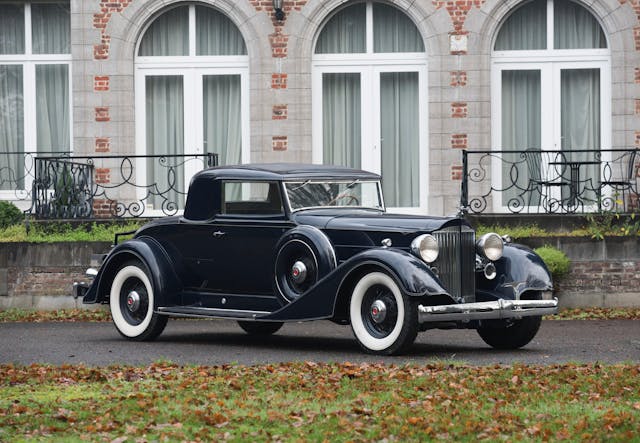
Estimate: $91,000—$120,000
Packards are commonly referred to as the American Rolls-Royce. The brand was one of the “Three Ps” of the great American cars of early motoring, along with Peerless and Pierce-Arrow. Founded in 1899 in Warren, Ohio, by brothers James Ward and William Doud Packard, the company moved to Detroit in 1903 after Henry Bourne Joy enlisted a group of investors to purchase the company. In the 1920s, Packard exported more cars than any other in its price class, and in 1930, sold almost twice as many abroad as any other marque priced at more than $2000. Between 1924 and 1930, Packard was also the top-selling luxury brand in America. The company survived the Great Depression only by launching a lower-priced model, the 120, which kept the company afloat but also diluted the brand by looking so similar to its more expensive stablemates. Sadly, the automaker failed to thrive in the years after World War II and ceased to exist in 1958 after an ill-advised merger with Studebaker.
In 1934, the company offered no fewer than 13 models in its Packard Eight lineup, and this rare “Rumble Seat” coupe features room for up to four as well as dual side-mounts spare wheels and a side hatch for storing golf clubs. This Packard first came to Europe in 1999, and between 2001 and 2003 was treated to a complete “chassis upwards” restoration in Germany. The engine and transmission were completely rebuilt, the clutch was replaced, and a new differential was manufactured to replace the original. The interior was retrimmed in dark blue leather, and since the aforementioned restoration the car was repainted in its current dark blue livery to match. Following its restoration, this Packard won several prizes at Concours d’Elegance competitions.
On average, we see about four of these at auction per year. One sold in Scottsdale 2017 for $126,500, then resold in 2019 at RM’s Phoenix sale for $100,800. Four of the last seven to come to auction in the past two years have sold, for a sell-through rate of 57%, and the average sale price in the last five years is $140,000. In that context, this could be a chance to snag a sinister-looking American classic at a relative bargain.
1938 Peugeot 402 Darl’Mat Special Sport
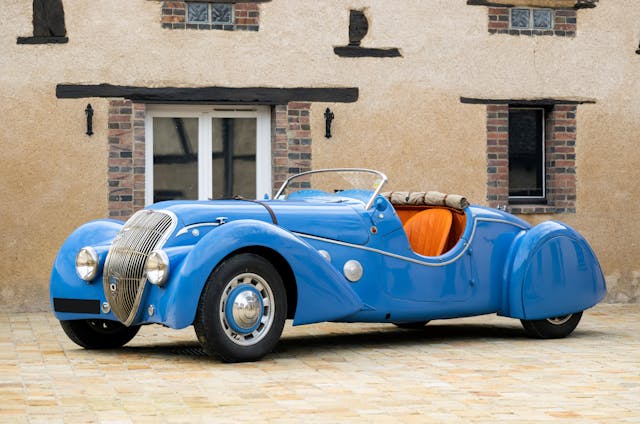
Estimate: $420,000—$670,000
Art Deco is a style of visual arts, architecture, and design that made its first appearance in France just before World War I. Art Deco had a profound effect on the design of buildings, furniture, jewelry, fashion, and cars. A sleeker form of Art Deco, called Streamline Moderne, appeared in the 1930s; it emphasized curving forms and smooth, polished surfaces.
The car offered here is a wonderful example of the style, and is one in a series of streamlined roadsters, coupes, and cabriolets styled by Georges Paulin and built by the French coachbuilder Marcel Pourtout for Émile Darl’Mat, whose Paris-based company was one of the world’s largest Peugeot agencies. Pourtout built approximately 105 of these streamlined cars for Darl’Mat between 1936 and 1939 (53 roadsters, 20 coupes, and 32 convertibles) and examples of the roadster ran competitively at Le Mans in 1937 and 1938.
One of an estimated 30-or-so survivors, and one of the very few in original condition, this appealing French beauty was manufactured on June 2, 1938. The current owner purchased the car at the Le Mans Classic auction in July 2012. Since then, the Darl’Mat has been treated to expert mechanical and cosmetic restoration at a cost of some $60,000.
A Darl’Matcame to Artcurial’s Rétromobile 2019 auction and sold for $354,779, but the highest price paid was at Gooding & Co’s 2017 Pebble Beach sale, when one changed hands for $742,500. These beautiful vehicles look like almost nothing else on the road and are sure to turn heads in any context.
1933 Lagonda 16/80hp Sports

Estimate: $130,000—$170,000
The Lagonda company was founded in 1906 in the United Kingdom by American-born Wilbur Gunn. He became a British national in 1891 and worked as a speedboat and motorcycle engineer. He named the company after the Shawnee Indian settlement “Lagonda” in modern-day Springfield, Ohio, the town where he was born. The company produced a number of various models, including the 1925 14/60 with a twin-cam 1,954-cc four-cylinder engine and hemispherical combustion chambers and later, in 1937, the legendary Rapide. Boasting a 4,480-cc V-12 good for 180 hp, the car was said to be able to go from 7 to 105 mph in top gear. Financial problems plagued the automaker throughout its existence, and in 1947, it was sold to David Brown, who had also recently bought Aston Martin.
The car on offer here is one of just twelve 16/80hp two-seaters bodied by Vanden Plas for Lagonda Motors and now, reportedly, one of only eight surviving worldwide. It was registered on the June 1, 1933 and was originally fitted with a Crossley 2.0-liter, six-cylinder engine. In the mid-1950s, the car was fitted with the present 2.0-liter four-cylinder engine (from a 1932 supercharged Lagonda). This engine now runs sans blower, inhaling through period-correct twin SU bronze-bodied carburetors. The car was kept on the road until the late 1960s, after which it went into storage for some 30 years. In 2004, the car was sold to David Acon, a well-known Aston Martin and Lagonda enthusiast, who had the restoration completed by the leading pre-war Aston Martin specialist Ecurie Bertelli and John Batt, a leading U.K. Lagonda specialist, at a cost north of $35,000.
The average price for a 16/80 in the last five years has been $58,000. The most recent sale is in November 2020 for a four-seat tourer that went for $58,300, and a two-seater sold for $93,702 in 2014. The target buyer here is = likely a die-hard Lagonda enthusiast who appreciates this vehicle’s history, provenance, and restoration quality.
1926 Salmson GSS Sports Tourer
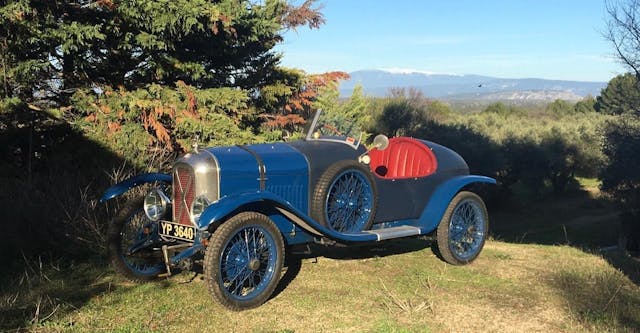
Estimate: $120,000—$170,000
Salmson was established by Émile Salmson in Paris in 1890, making steam-powered compressors and centrifugal pumps for railway and military purposes. The company became one of the first to make purpose-built aircraft engines, starting before World War I. After World War I, the company looked around for other work and started making car bodies and then complete cars. In 1929, the company founded a British branch company, Moteurs Salmson in Raynes Park, London, as a manufacturer of airplane engines for the British Empire market. In 1930, it was acquired by a group of investors led by British sports car racer Howard Martineau. They renamed the company British Salmson Aero Engines Ltd and continued production of the airplane engines under license. Faced with dwindling sales, the company extended the license deal to include local production of cars from 1934. After manufacturing war supplies during World War II, it ceased car production, moved to Glasgow, Scotland, and produced printing machinery.
This car was sold new in the U.K. in 1926 and boasts an illustrated competition history covering its earliest days at Brooklands up to more recent VSCC events in Britain, as its many scrutineering tags in the cockpit attest. The seller describes the car as being in very good condition throughout, with matching chassis and engine numbers.
On average, pre-war Salmsons cost $90,000, but the top sale for one was back in 2015 when a “San Sebastian” Grand Prix sold for a whopping $363,000.


